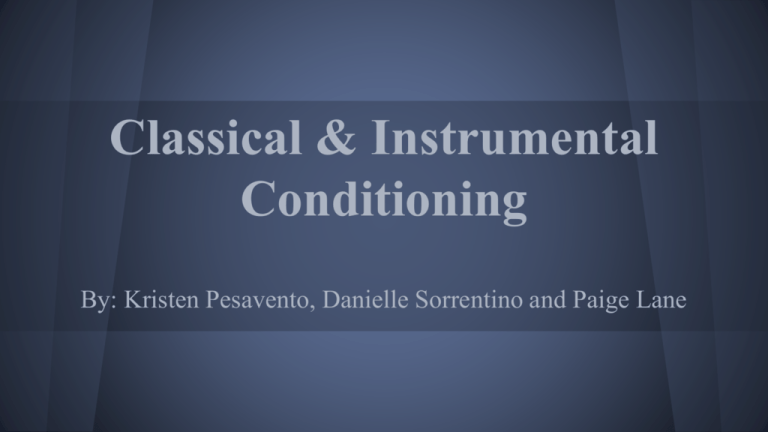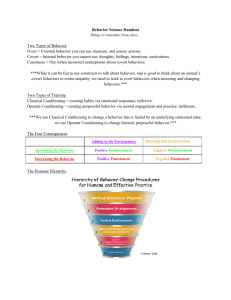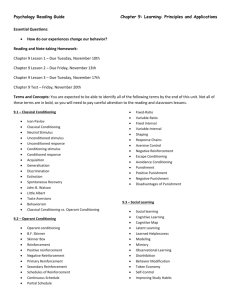Classical & Instrumental Conditioning - unh
advertisement

Classical & Instrumental Conditioning By: Kristen Pesavento, Danielle Sorrentino and Paige Lane Behaviorism Every behavior that a child does is learned. Everything you do in your classroom can affect your child’s behavior. (Ormrod, 2014) Behaviorism ● Theoretical perspective in which learning and behavior are described and explained in terms of stimulus-response relationships. o Stimulus: Specific object or event that influences an individual’s learning or behavior. o Response: Specific behavior that an individual exhibits. (Ormrod, 2014) All behaviors are acquired through conditioning. (Waston, 1977) Classical Conditioning/Respondent Conditioning ● “We sometimes learn involuntary responses as a result of two stimuli being present at approximately the same time” (Ormrod, 2014 p. 267). ○ Unconditioned stimulus (UCS)- stimulus that elicits a particular response without prior learning. ○ Unconditioned response(UCR)- response that is evoked by a particular unconditioned stimulus without prior learning. ○ Conditioned stimulus (CS)- stimulus that elicits a particular response when paired with the unconditioned stimulus. ○ Conditioned response (CR)- response that results from the pairing of the UCS and CS. US, UR, CS, CR Classical Conditioning Worksheet ● Work in pairs for the next three minutes and complete the worksheet. When your worksheet is completed, we will share it as a class. Instrumental Conditioning ● Increasing or decreasing behaviors as a result of reinforcement or punishment. Instrumental Conditioning Instrumental Conditioning ● Positive Reinforcement: A student is praised for writing an assignment in cursive. She begins to write other assignments in cursive as well. ● Negative Reinforcement: A student worries about a research paper he has coming due. He completes the paper several days before the due date. Because he removed his worry feeling, he begins to do his assignments ahead of time whenever possible. ● Presentation Punishment: Student is ridiculed for what classmates think is a “stupid” question→ student stops asking questions. ● Removal Punishment: A student loses points on a test for answering a question in a creative way. She takes fewer risks on future tests. What to take away from Instrumental Conditioning: ● Teachers should focus on reinforcing desirable behaviors. ● Punishment is ineffective in the classroom. ● Extrinsic reinforcers lose their effectiveness when used repeatedly. ● By using reinforcement you can shape positive classroom behaviors. Ways to Implement Behaviorism in the Classroom ● Create a classroom environment that fosters desirable student behaviors. o Praise a student every time s/he completes an assignment without having to be prompted. ● Conclude learning has occurred when students exhibit a change in classroom performance. o Implementing regular assessments. Exit Slip How could you implement conditioning in your classroom to ensure student success?







